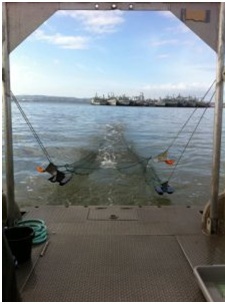Endangered Delta Smelt Population Improves
 Young Delta smelt abundance this year roughly doubled when compared to last year but is a small fraction of their historical abundance, state biologists say. The improvement is likely due in large part to higher than usual flows from the San Joaquin and Sacramento rivers this year which resulted in better habitat conditions and water quality.
Young Delta smelt abundance this year roughly doubled when compared to last year but is a small fraction of their historical abundance, state biologists say. The improvement is likely due in large part to higher than usual flows from the San Joaquin and Sacramento rivers this year which resulted in better habitat conditions and water quality.
Because it is exceptionally difficult to determine the actual number of Delta smelt, Department of Fish and Game (DFG) biologists use survey data to develop “indices” of the species’ abundance. An index is a number that is likely to vary in direct proportion to abundance. For example, if a hypothetical index were to double from 4 to 8 then abundance would also have doubled (e.g., from 200,000 to 400,000).
The 20-Millimeter Survey index of young Delta smelt abundance – which has been developed yearly since 1995 and is named after the approximate size of fish it collects – was 8.0 this year while the index in 2010 was 3.8 and its record high was 39.7 in 1999. The Summer Tow Net Survey index of slightly-older Delta smelt abundance – which has been developed yearly since 1959 and is named after the type of net used to collect fish – was 2.2 this year while the index in 2010 was 0.8 and the record high was 62.5 in 1978.
The increased number of young Delta smelt is encouraging, but because it is still early in their one-year life cycle, the abundance of adults may or may not increase similarly. DFG will continue to monitor the population and at the conclusion of the Fall Midwater Trawl Survey in December will calculate and then release an index of sub-adult Delta smelt abundance.
Delta smelt occur only in the Sacramento-San Joaquin River Delta. The finger-sized fish was historically one of the most abundant in the Delta, but the species declined substantially and was listed as threatened under the California and Federal Endangered Species acts (ESA) in 1993. After a further decline, the species was designated as endangered in 2010 under the California ESA.
Ongoing efforts to protect and recover the population include research on threats to the species, active management to minimize loss at water diversions under federal ESA biological opinions and a state ESA authorization, development of the Bay Delta Conservation Plan, improved water quality, habitat restoration and conservation of genetic diversity through special hatchery-rearing techniques.
To see how the indices of Delta smelt abundance have varied over the years, please visit www.dfg.ca.gov/delta/data/townet/indices.asp?species=3and http://nrm.dfg.ca.gov/FileHandler.ashx?DocumentID=34731.
the attachments to this post:






















As a person very interested in the water policies in the State of CA especially as they relate to the Delta and our water sheds in this area, I am looking for others who also have this interest and are involved in getting and sharing knowledge of and taking action in the complex decisions that are being planned and will impact our region. Contact lsolivenster@gmail.com, if you are interested in citizen collaboration and activity that pertains to the Delta.
This just proves that good fresh water flows through the Delta to the bay and Ocean are critical to the health of the Delta.